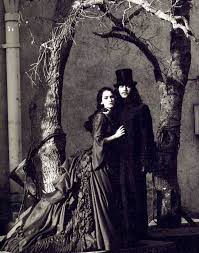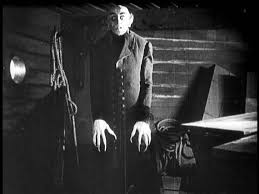Dracula is an 1897 epistolary novel by Irish author
Bram Stoker, featuring as its primary antagonist the vampire Count Dracula.
Dracula has been assigned to many literary genres including vampire literature, horror fiction, the gothic novel and invasion literature. Structurally it is anepistolary novel, that is, told as a series of letters, diary entries, ships' logs, etc. Literary critics have examined many themes in the novel, such as the role of women in Victorian culture, conventional and conservative sexuality, immigration, colonialism, postcolonialism and folklore. Although Stoker did not invent the vampire, the novel's influence on the popularity of vampires has been singularly responsible for many theatrical, film and television interpretations since its publication.

The tale begins with Jonathan Harker, a newly qualified English solicitor, journeying by train and carriage from England to Count Dracula's crumbling, remote castle (situated in the Carpathian Mountains on the border of Transylvania, Bukovina and Moldavia). The purpose of his mission is to provide legal support to Dracula for a real estate transaction overseen by Harker's employer, Peter Hawkins, of Exeter in England. At first enticed by Dracula's gracious manner, Harker soon discovers that he has become a prisoner in the castle. He also begins to see disquieting facets of Dracula's nocturnal life. One night while searching for a way out of the castle, and against Dracula's strict admonition not to venture outside his room at night, Harker falls under the spell of threewanton female vampires, the Brides of Dracula. He is saved at the last second by the Count, because he wants to keep Harker alive just long enough to obtain needed legal advice and teachings about England and London (Dracula's planned travel destination was to be among the "teeming millions"). Harker barely escapes from the castle with his life... (keep reading the rest of the plot
HERE)

FILM ADAPTATIONS:
The story of Dracula has been the basis for countless films and plays. Stoker himself wrote the first theatrical adaptation, which was presented at the Lyceum Theatre under the title Dracula, or The Undead shortly before the novel's publication and performed only once. Popular films include Dracula (1931), Dracula (alternative title: The Horror of Dracula) (1958), and Dracula (also known as Bram Stoker's Dracula) (1992). Dracula was also adapted as Nosferatu (1922), a film directed by the German director F.W. Murnau, without permission from Stoker's widow; the filmmakers' attempted to avoid copyright problems by changing many of the details. (Go to the topic about
The Silent Era Movies to know more about this adaptation!)
The character of Count Dracula has remained popular over the years, and many films have used the character as a villain, while others have named him in their titles, such as Dracula's Daughter, The Brides of Dracula, and Zoltan, Hound of Dracula. As of 2009, an estimated 217 films feature Dracula in a major role, a number second only to Sherlock Holmes (223 films).
Most adaptations do not include all the major characters from the novel. The Count is always present, and Jonathan and Mina Harker, Dr. Seward, Dr. Van Helsing, and Renfield usually appear as well. The characters of Mina and Lucy are often combined into a single female role. Jonathan Harker and Renfield are also sometimes reversed or combined. Quincey Morris and Arthur Holmwood are usually omitted entirely.
Fun Facts: The character of Count Dracula has been used also for a brand of cereals that Goths love called Count Chocula! :P

























No comments:
Post a Comment